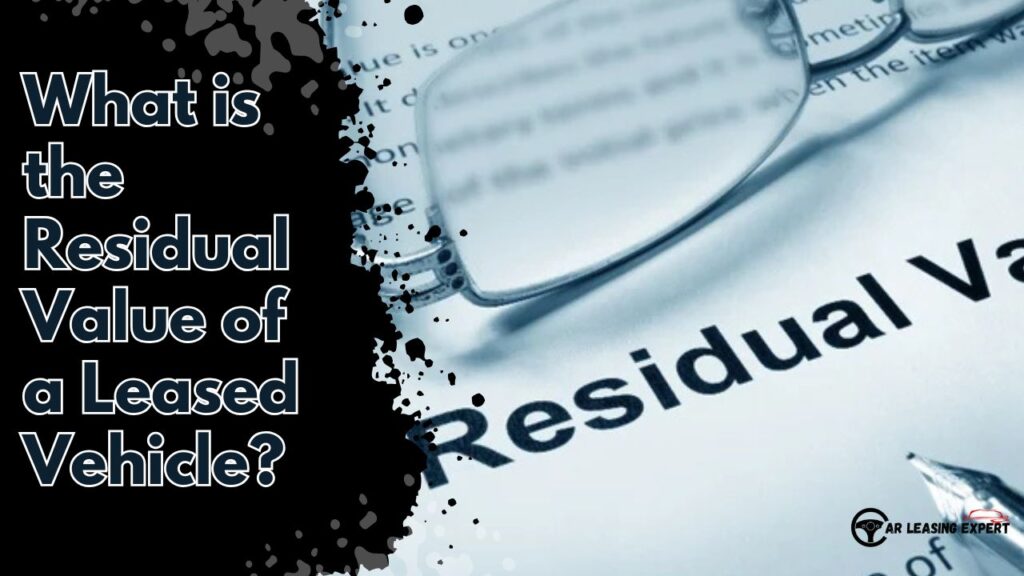When you hear the term “residual value,” it might sound like complicated financial talk. However, if you’ve ever leased a car, equipment, or property, understanding this concept is crucial. Residual value isn’t just a number—it’s a key part of your lease agreement.
For a leased vehicle, the residual value plays a major role in shaping the cost and terms of the lease. By understanding how it works, you can make smarter decisions when leasing a car. Here’s a closer look at what residual value means and why it matters.

What Is Residual Value in Lease?
A car’s residual value is its worth at the end of the lease term. It’s also the price you can pay to buy the car once the lease ends. When you sign a car lease agreement, you’ll be given a residual percentage, which helps you estimate the car’s value at the end of the lease. Your monthly lease payment primarily covers the car’s depreciation over the lease period, along with added fees and interest.
Examples of Residual Value in Leasing
Let us take an example of a lease offer and calculate the residual value.
MSRP – $30,000
Residual – 50%
Lease term – 36 months (10,000miles/year)
To get the residual value, you take 50% of the MSRP and your residual value will be $15,000.
How Residual Value Is Calculated
Manufacturer’s Suggested Retail Price (MSRP): The initial value of the vehicle when it is new.
Depreciation Rate: The rate at which the vehicle is expected to lose value over time.
Lease Term: The length of the lease, which is typically 24 to 36 months.
Residual value is often expressed as a percentage of the MSRP. For example, if a car has an MSRP of $30,000 and a residual value of 50%, the residual value at the end of the lease term would be $15,000.
Knowing how to calculate residual value is helpful if you want to estimate your monthly car lease payments and avoid overpaying. As you probably know, a car loses value the longer you drive it. To figure out its exact residual value, you’ll need the vehicle’s manufacturer’s suggested retail price (MSRP) and the residual value percentage rate.
The easiest way to find the residual value percentage is to check your lease agreement. If it’s not listed there, you can ask the lessor for the information. Keep in mind that older cars with low resale values might not have a residual value calculation. Lessors determine residual values based on several factors, starting with the car’s market value, expected mileage, and lease term. However, these calculations can get complicated.
Types of Leases and Residual Value
When considering a car lease, it’s essential to understand the different types of leases available and how residual value plays a role in each. Here are the main types of leases and their relationship to residual value:
1. Closed-end lease (lease-to-own)
A closed-end lease is the most common type of car lease. At the end of the lease term, you can return the car and walk away with no further obligations, provided you haven’t exceeded the mileage limit or caused excessive wear and tear.
The residual value is determined in advance at the beginning of the lease. Your monthly payments are based on the cost of depreciation (initial value minus residual value). A higher residual value results in lower monthly payments.
2. Open-end lease (financial lease)
An open-end lease is less common and is typically used for business purposes. At the end of the lease term, you must either purchase the car or cover the difference between the residual value and the market value of the car.
The residual value is calculated at the start of the lease, but can be adjusted based on the vehicle’s actual market value at the end of the lease. This type of lease carries more risk, as you may owe additional money if the vehicle’s value is less than the estimated residual value.
Benefits of Knowing Residual Value
Understanding the residual value of a leased vehicle offers several benefits that can help you make informed decisions and potentially save money. Here are some key advantages:
Lower monthly payments
Knowing the residual value helps you understand the cost of depreciation, which directly affects your monthly lease payments. A higher residual value means lower depreciation and, therefore, lower monthly payments.
Informed lease negotiation
Armed with knowledge about residual values, you can negotiate better lease terms with the dealer. You’ll be able to compare offers and choose a lease with favorable terms.
Lease purchase decision
Understanding the residual value helps you decide whether it’s financially beneficial to buy the leased vehicle at the end of the lease period. If the residual value is lower than the market value, buying the car could be a good deal.
Financial planning
Knowing the residual value allows you to plan your budget more effectively. You’ll have a clearer idea of the total cost of leasing the vehicle and can allocate funds accordingly.
Avoid surprises
Knowing the residual value will help you avoid unexpected costs at the end of the lease period. You’ll know what to expect in terms of end-of-lease options and potential termination costs.
Impact of Residual Value on Monthly Payments
The residual value of a leased vehicle has a significant impact on monthly lease payments. Here’s how it works:
Depreciation cost
The primary factor in determining monthly lease payments is the vehicle’s depreciation cost, which is the difference between the initial value (MSRP) and the residual value.
High residual value: If the residual value is high, the vehicle depreciates less over the lease term, resulting in lower monthly payments.
Low residual value: If the residual value is low, the vehicle depreciates more over the lease term, resulting in higher monthly payments.
Example Calculation
Let’s compare two scenarios with different residual values:
Scenario A:
MSRP: $30,000
Residual Value: 60% ($18,000)
Depreciation Cost: $30,000 – $18,000 = $12,000
Monthly Payment (36-month lease): $12,000 / 36 = $333.33
Scenario B:
MSRP: $30,000
Residual Value: 50% ($15,000)
Depreciation Cost: $30,000 – $15,000 = $15,000
Monthly Payment (36-month lease): $15,000 / 36 = $416.67
A higher residual value results in lower monthly lease payments because the vehicle retains more of its value over the lease term, which reduces the depreciation cost you have to cover. Conversely, a lower residual value increases monthly payments due to higher depreciation.
Residual Value vs. Buyout Price
A lease buyout lets you purchase your leased vehicle when the lease ends. Some lease agreements include a buyout option, making it easier to buy the car even after the lease term. The buyout price is usually based on the car’s residual value. To decide if a buyout is a good idea, compare the car’s market value to its residual value. If the car is worth more than the residual value, a buyout can be a smart move. If not, it might be better to pass on the deal.
If you choose to buy, you’ll own the car at the end of the lease. A car can be a valuable asset, and after its useful life, you can resell it or trade it in for a new one. While a vehicle’s useful life varies, many leased cars remain reliable for years. Whether to buy your leased car depends on your budget and what fits your needs..
How Lenders Use Residual Value
Lenders use residual value to evaluate risk. By accurately calculating it, they reduce the chance of losing money if the asset’s value drops faster than anticipated.
Tips for Negotiating Residual Value
If a lease buyout is an option, the leasing company must disclose the vehicle’s residual value when you sign the lease. In fact, any lease with a buyout option will clearly include the residual value. However, unlike other lease terms, you typically can’t negotiate this value.
A higher residual value indicates the car is expected to hold its value well and depreciate less over the lease term. Since most of your lease payment covers depreciation, a higher residual value often leads to lower monthly payments.
However, if the residual value is set too high and the car ends up being worth less than that amount at the end of the lease, you might overpay if you choose to buy it.
Should I buy my leased car for the residual value?
It’s common for a lease to include an option to purchase the vehicle for its residual value at the end of the lease. If your vehicle is actually worth more than its estimated residual value, this would be a great deal.
Final Thoughts
Residual value is the unsung hero of lease agreements, as it influences everything from monthly payments to purchase options. Understanding it will allow you to make informed decisions, save money, and negotiate better terms.
FAQs
What is a good residual value percentage?
A good residual value is typically 50% or more, but it varies by asset type and lease term.
Can residual value be negotiated in a lease?
Yes, although it is more common to negotiate other terms, such as capitalized cost or monthly payments.
How does residual value affect taxes?
Residual value can influence taxable amounts, especially if you choose to purchase the asset at the end of the lease.
What happens if residual value is higher than market value?
If residual value exceeds market value, returning the asset might be your best option to avoid overpaying.
Does residual value affect options at the end of the lease?
Absolutely! Determine whether buying, returning, or renewing the lease makes financial sense.





